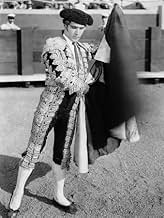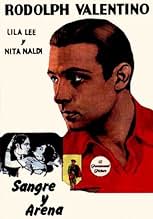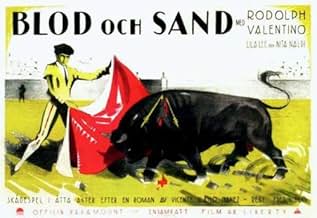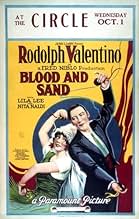NOTE IMDb
6,3/10
1,6 k
MA NOTE
Ajouter une intrigue dans votre langueA toreador's (Rudolph Valentino) familial and social life is threatened when he has an affair.A toreador's (Rudolph Valentino) familial and social life is threatened when he has an affair.A toreador's (Rudolph Valentino) familial and social life is threatened when he has an affair.
- Réalisation
- Scénario
- Casting principal
- Récompenses
- 1 victoire au total
Rudolph Valentino
- Juan Gallardo
- (as Rodolph Valentino)
Rosa Rosanova
- Angustias
- (as Rose Rosanova)
W.E. Lawrence
- Fuentes
- (as William Lawrence)
Michael Dark
- Doña Sol's New Lover
- (non crédité)
Avis à la une
BLOOD AND SAND (Paramount, 1922), directed by Fred Niblo, stars silent screen legend Rudolph (billed Rodolph) Valentino in one of his most celebrated roles as a bullfighter from the suburbs of Seville whose rise to fame eventually puts his life into a different direction. While the title might indicate violence at the beach, such as sunbathers and swimmers encountering shark attacks, (director Steven Spielberg took care of that with his 1975 hit, JAWS), the movie only lives up to its name towards the end of the story.
Set in Spain, the plot revolves around Juan Gallardo (Rudolph Valentino), also known as "Zapaterin" (The Little Shoemaker), who longs to become a famous matador in spite of the protests from his widowed mother (Rosa Rosanova) wanting her son to have a more safer profession by following his late father's trade working as a shoemaker, but that doesn't go well with him. As his dreams become reality, Juan, having made a name for himself, is reunited with Carmen Espinosa (Lila Lee), his childhood playmate now back home from convent school. The two marry, and as he rises to the top of his profession, Juan offers her wealth and happiness. Things start to change as Juan meets and succumbs to the passionate charms of Dona Sol (Nita Naldi), niece of the Marquis De Moraimas (George Pierlot).
Of the supporting players featuring George Field as El Nacional; Rosita Marsiti as Encarnacion; Leo White as Antonio; Fred Becker as Don Jose; among others, the character who is most essential to the story is Don Joselito (Charles Belcher), a philosopher, whose home is surrounded with ancient instruments of torture (superimposed with people strapped and tied to these devises). He writes recorded documents about various people who interest him, and what is to become of them, namely Juan and his bandit friend, Plumitas (Walter Long), whose backgrounds differ but with parallel professions (Juan kills bulls while Plumitas kills men), each are to have similar ends. Joselito writes this about Juan, "Juan Gallardo has reached his goal. Will success spoil him or will his love for little Carmen overcome the plaudits of the populace and the cruelty of the national sport?"
The now familiar Vicente Blasco Ibanez story was remade successfully and memorably by 20th Century-Fox in 1941 starring Tyrone Power, Linda Darnell and Rita Hayworth in the Valentino, Lee and Naldi roles. Longer than its predecessor, the remake includes a lengthy opening tracing the early life of Juan as a boy while the Valentino original centers upon his Juan as an adult, with very little about his upbringing, thus, being mostly a dramatic story on the personal life of an acclaimed matador. In spite of its premise, BLOOD AND SAND consists of limited bullfighting scenes, compared to several used in the remake, each featuring memorable love scenes between Juan and his mistress, Dona Sol. While Nita Naldi's performance might come off as campy, Rita Hayworth's interpretation is most alluring. Fred Niblo's direction may be slow going at times, but manages to bring the culture and Spain to life, especially with their afternoon recreation as they are seem being entertained by watching a good bullfight. Ole! Ole!
Because of his early death in 1926 at age 31, the Valentino name has become immortal. BLOOD AND SAND, along with THE FOUR HOURSEMEN OF THE APOCALYSE (1921), THE SHEIK (1921) and its sequel, THE SON OF THE SHEIK (1926) have become notable titles that best personify the Valentino legend, yet, television revivals have become rare. BLOOD AND SAND did become one of the thirteen movies presented on public television's weekly series of "The Silent Years" (1971), hosted by Orson Welles, with film print from the Paul Killiam collection,accompanied by a piano score by William Perry, the print used for the Blackhawk (later Republic Home Video) distribution during the early 1990s. At one point, BLOOD AND SAND was shown on cable television on the Nostalgia Channel around 1993-4 as part of its Saturday evening showing of "When Silents Was Golden." A decade later, KINO VIDEO restored BLOOD AND SAND with clearer picture quality and corrected silent film speed, as well as some restored footage missing from the standard 82 minutes (including the opening of the Paramount logo), thus, moving its length up to 110 minutes. The KINO print is accompanied by a new score by Rodney Sauer and the Mont Alto Motion Picture Orchestra. But beware of shorter prints running at 62 minutes, the abridged print that played on numerous occasions on Turner Classic Movies' "Silent Sunday Nights" prior to 2000.
BLOOD AND SAND is classic Valentino at best. Aside from playing a young man with ambition, a tango dancer, and a lover of women (although a title card earlier in the story has him saying "I hate all women except one"), Valentino is perfectly cast as the bullfighter of Seville, and that's no bull. Viva, Valentino!
Set in Spain, the plot revolves around Juan Gallardo (Rudolph Valentino), also known as "Zapaterin" (The Little Shoemaker), who longs to become a famous matador in spite of the protests from his widowed mother (Rosa Rosanova) wanting her son to have a more safer profession by following his late father's trade working as a shoemaker, but that doesn't go well with him. As his dreams become reality, Juan, having made a name for himself, is reunited with Carmen Espinosa (Lila Lee), his childhood playmate now back home from convent school. The two marry, and as he rises to the top of his profession, Juan offers her wealth and happiness. Things start to change as Juan meets and succumbs to the passionate charms of Dona Sol (Nita Naldi), niece of the Marquis De Moraimas (George Pierlot).
Of the supporting players featuring George Field as El Nacional; Rosita Marsiti as Encarnacion; Leo White as Antonio; Fred Becker as Don Jose; among others, the character who is most essential to the story is Don Joselito (Charles Belcher), a philosopher, whose home is surrounded with ancient instruments of torture (superimposed with people strapped and tied to these devises). He writes recorded documents about various people who interest him, and what is to become of them, namely Juan and his bandit friend, Plumitas (Walter Long), whose backgrounds differ but with parallel professions (Juan kills bulls while Plumitas kills men), each are to have similar ends. Joselito writes this about Juan, "Juan Gallardo has reached his goal. Will success spoil him or will his love for little Carmen overcome the plaudits of the populace and the cruelty of the national sport?"
The now familiar Vicente Blasco Ibanez story was remade successfully and memorably by 20th Century-Fox in 1941 starring Tyrone Power, Linda Darnell and Rita Hayworth in the Valentino, Lee and Naldi roles. Longer than its predecessor, the remake includes a lengthy opening tracing the early life of Juan as a boy while the Valentino original centers upon his Juan as an adult, with very little about his upbringing, thus, being mostly a dramatic story on the personal life of an acclaimed matador. In spite of its premise, BLOOD AND SAND consists of limited bullfighting scenes, compared to several used in the remake, each featuring memorable love scenes between Juan and his mistress, Dona Sol. While Nita Naldi's performance might come off as campy, Rita Hayworth's interpretation is most alluring. Fred Niblo's direction may be slow going at times, but manages to bring the culture and Spain to life, especially with their afternoon recreation as they are seem being entertained by watching a good bullfight. Ole! Ole!
Because of his early death in 1926 at age 31, the Valentino name has become immortal. BLOOD AND SAND, along with THE FOUR HOURSEMEN OF THE APOCALYSE (1921), THE SHEIK (1921) and its sequel, THE SON OF THE SHEIK (1926) have become notable titles that best personify the Valentino legend, yet, television revivals have become rare. BLOOD AND SAND did become one of the thirteen movies presented on public television's weekly series of "The Silent Years" (1971), hosted by Orson Welles, with film print from the Paul Killiam collection,accompanied by a piano score by William Perry, the print used for the Blackhawk (later Republic Home Video) distribution during the early 1990s. At one point, BLOOD AND SAND was shown on cable television on the Nostalgia Channel around 1993-4 as part of its Saturday evening showing of "When Silents Was Golden." A decade later, KINO VIDEO restored BLOOD AND SAND with clearer picture quality and corrected silent film speed, as well as some restored footage missing from the standard 82 minutes (including the opening of the Paramount logo), thus, moving its length up to 110 minutes. The KINO print is accompanied by a new score by Rodney Sauer and the Mont Alto Motion Picture Orchestra. But beware of shorter prints running at 62 minutes, the abridged print that played on numerous occasions on Turner Classic Movies' "Silent Sunday Nights" prior to 2000.
BLOOD AND SAND is classic Valentino at best. Aside from playing a young man with ambition, a tango dancer, and a lover of women (although a title card earlier in the story has him saying "I hate all women except one"), Valentino is perfectly cast as the bullfighter of Seville, and that's no bull. Viva, Valentino!
You know the story even if you've never heard of this movie: young man becomes famous and starts cheating on his wife. Good characterizations and vivid backgrounds can't save the tired (even for its time) plot. Bullfighting scenes are more curious than exciting. Director Niblo's talents do not shine as brightly as in Ben-Hur 3 years later. The 1941 remake is better.
I've watched "Blood and Sand" several times; I own the DVD. With every viewing I notice some new subtle nuance in the under played gestures of Valentino. In the big seduction scene between Valentino and the voluptuous Nita Naldi, she sits at a harp, delicately playing, with her back to Valentino. He walks up behind her chair, clearly aroused, and he begins to seductively stroke the chair! This is so under played and yet so visually compelling and sensuous.It is so unlike the melodramatic rather hystrionic aesthetic so often found in films from this period. Valentino's restraint throughout the film's more emotional moments is compelling; his subtlety pulls the viewer intimately inward.True, the bull fighting scenes leave a bit to be desired. They are the result of some rather choppy editing and sadly come off looking peculiar,even humorous at times. Somehow Valentino pulls it off, his graceful movements, his quiet emotions, his compelling sensuality more than make up for the lack of authenticity in the bullring.
"Blood and Sand" tells us many times how cruel and dangerous it believes bullfighting to be, but in terms of what it actually shows us, it seems far more interested in the romantic qualities of Rudolph Valentino and his larger-than-life love triangle.
Valentino gives a legitimately good performance, but even the love story loses some of its immediacy from the fact that "Blood and Sand" takes its subject at some distance, periodically stepping back and focusing on the scholar who foreshadows the matador's end. This also allows some of the characterization to go without being fully realized. When all is said and done it is neither believable as an anti-bullfighting film nor totally involving as a story of a love triangle, but some of the elements, including the performances and some excellent symbolic imagery, are well realized.
Valentino gives a legitimately good performance, but even the love story loses some of its immediacy from the fact that "Blood and Sand" takes its subject at some distance, periodically stepping back and focusing on the scholar who foreshadows the matador's end. This also allows some of the characterization to go without being fully realized. When all is said and done it is neither believable as an anti-bullfighting film nor totally involving as a story of a love triangle, but some of the elements, including the performances and some excellent symbolic imagery, are well realized.
Although in many ways "Blood and Sand" looks rather old-fashioned now, it's still an interesting drama. It gives Rudolph Valentino one of his better roles, and it is also highlighted by an effective supporting performance from Nita Naldi. The subject matter has some substance to it, and it still holds up well enough despite being handled occasionally in a somewhat heavy-handed manner.
In playing the bullfighter Gallardo, Valentino gets a character with some depth to it. The story follows him as he first struggles to achieve fame and respect, and then struggles in dealing with the side-effects of fame, fortune, and popularity. Naldi's role is memorable, and from her first appearance she makes her manipulative vamp character physically desirable but an obvious source of danger. Valentino does a good job playing off of her, and even without the benefit of spoken dialogue it is easy to see the struggle and self-reproach taking place inside of him.
The themes have a significance that go beyond the original setting. In itself, the criticisms of bullfighting and of what it reveals about human nature, while generally quite valid, are put forth without any subtlety. The inter-titles and the obvious parallels between Gallardo and the notorious criminal Plumitas repeatedly emphasize the same points that the action itself could have made well enough on its own. But that's one of the few weaknesses of "Blood and Sand". And the more general point, its depiction of how easy it is for crowds to be thrilled with violence, is well-taken.
The one other noticeable shortcoming is that the bullring scenes are now often unconvincing. It is laudable, of course, that the film-makers were willing to sacrifice realism so as to avoid being cruel to the animals, so this particular aspect of the movie should be evaluated generously. Present-day technology would certainly have made it much simpler to achieve both goals.
Although the style might make it mostly of interest to those who are already silent movie fans, there is still more than enough of interest to make this worth seeing. The story is simple, but it has some worthwhile aspects. Naldi provides something striking to look at, and Valentino gets to show what he can do with a role that has some possibilities to it.
In playing the bullfighter Gallardo, Valentino gets a character with some depth to it. The story follows him as he first struggles to achieve fame and respect, and then struggles in dealing with the side-effects of fame, fortune, and popularity. Naldi's role is memorable, and from her first appearance she makes her manipulative vamp character physically desirable but an obvious source of danger. Valentino does a good job playing off of her, and even without the benefit of spoken dialogue it is easy to see the struggle and self-reproach taking place inside of him.
The themes have a significance that go beyond the original setting. In itself, the criticisms of bullfighting and of what it reveals about human nature, while generally quite valid, are put forth without any subtlety. The inter-titles and the obvious parallels between Gallardo and the notorious criminal Plumitas repeatedly emphasize the same points that the action itself could have made well enough on its own. But that's one of the few weaknesses of "Blood and Sand". And the more general point, its depiction of how easy it is for crowds to be thrilled with violence, is well-taken.
The one other noticeable shortcoming is that the bullring scenes are now often unconvincing. It is laudable, of course, that the film-makers were willing to sacrifice realism so as to avoid being cruel to the animals, so this particular aspect of the movie should be evaluated generously. Present-day technology would certainly have made it much simpler to achieve both goals.
Although the style might make it mostly of interest to those who are already silent movie fans, there is still more than enough of interest to make this worth seeing. The story is simple, but it has some worthwhile aspects. Naldi provides something striking to look at, and Valentino gets to show what he can do with a role that has some possibilities to it.
Le saviez-vous
- AnecdotesThe film's editor was Dorothy Arzner, who would later go on to become Hollywood's first female director. Arzner impressed the producers by cannily interspersing stock bull-fighting footage with shots of Rudolph Valentino to make it look like the actor was actually in the ring with real bulls. This was quite a progressive technique in its day.
- GaffesThe mountain bandit who is one of the principal supporting characters is an anachronism; the Guardia Civil did away with their kind during the late 19th century.
- Citations
Juan Gallardo: We spread our capes for your amusement and most generous alms.
- ConnexionsEdited into Michael Blanco (2004)
Meilleurs choix
Connectez-vous pour évaluer et suivre la liste de favoris afin de recevoir des recommandations personnalisées
- How long is Blood and Sand?Alimenté par Alexa
Détails
Box-office
- Montant brut aux États-Unis et au Canada
- 2 725 000 $US
- Durée1 heure 48 minutes
- Mixage
- Rapport de forme
- 1.33 : 1
Contribuer à cette page
Suggérer une modification ou ajouter du contenu manquant

Lacune principale
By what name was Arènes sanglantes (1922) officially released in Canada in English?
Répondre




































